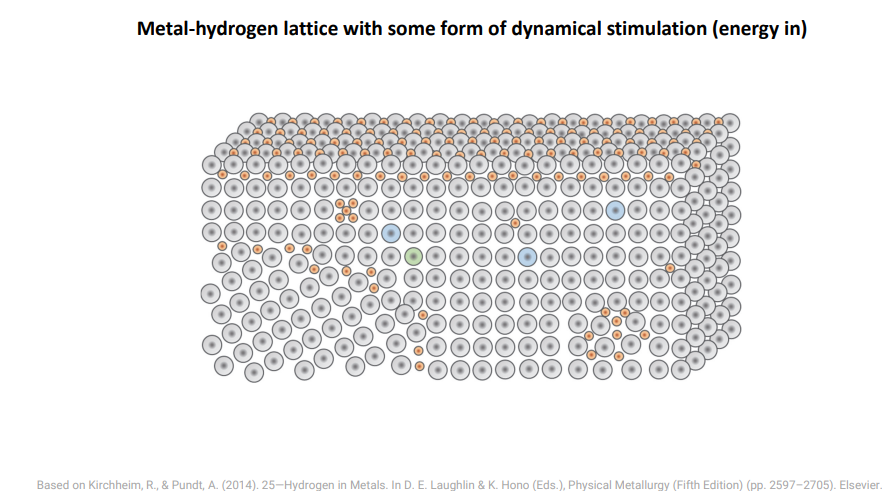
Posted on 02/20/2022 4:36:43 PM PST by Kevmo
ARPA-E LENR Workshop October 21, 2021
Toward a LENR Reference Experiment Florian Metzler, PhD Research Scientist, MIT fmetzler@mit.edu
Some of the slides he used during this presentation.
They have very intriguing diagrams of the lattice structure and the nuclear reactions within the lattice, explaining various nuclear products and even the ABSENCE of certain nuclear products.
--------------------------------------------------------------------------------------------------------------------------------------
Common denominator at the nano level
Metal‐hydrogen lattice with some form of dynamical stimulation (energy in)

Based on Kirchheim, R., & Pundt, A. (2014). 25—Hydrogen in Metals. In D. E. Laughlin & K. Hono (Eds.), Physical Metallurgy (Fifth Edition) (pp. 2597–2705). Elsevier.
-----------------------------------------------------------------------------------------------------------------
Common denominator at the nano level
Metal‐hydrogen lattice with some form of dynamical stimulation (energy in)
Lattice composition
Lattice morphology
Breakage of Chemical Bonds
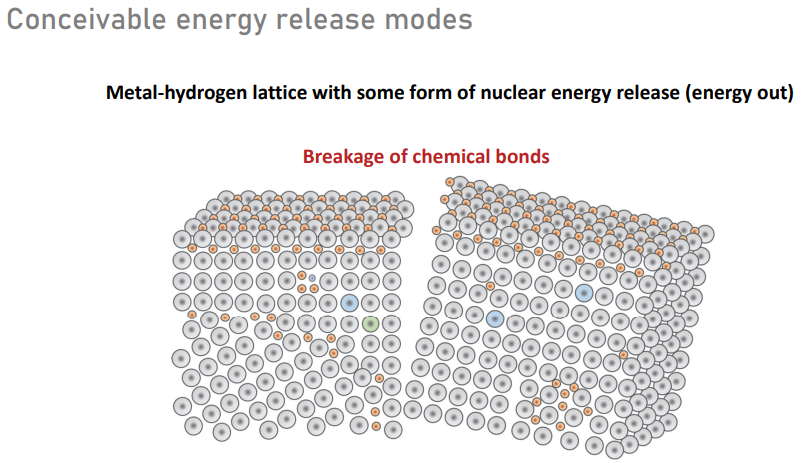
---------------------------------------------------------------------------------------------------------------------------------------------
Common denominator at the nano level
Metal‐hydrogen lattice with some form of dynamical stimulation (energy in)
Kinetic energy in
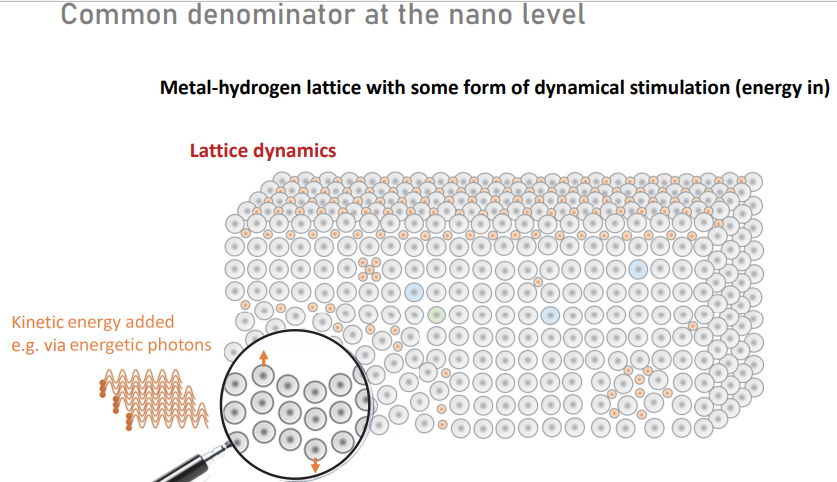
Kinetic energy added
e.g. via energetic photon
Nuclear potential energy E = mc2
Atomic potential energy
Energy balance sheet Epotential (chemical)
-----------------------------------------------------------------------------------------------------------------------------------------
Conceivable energy release modes
Metal‐hydrogen lattice with some form of nuclear energy release (energy out)
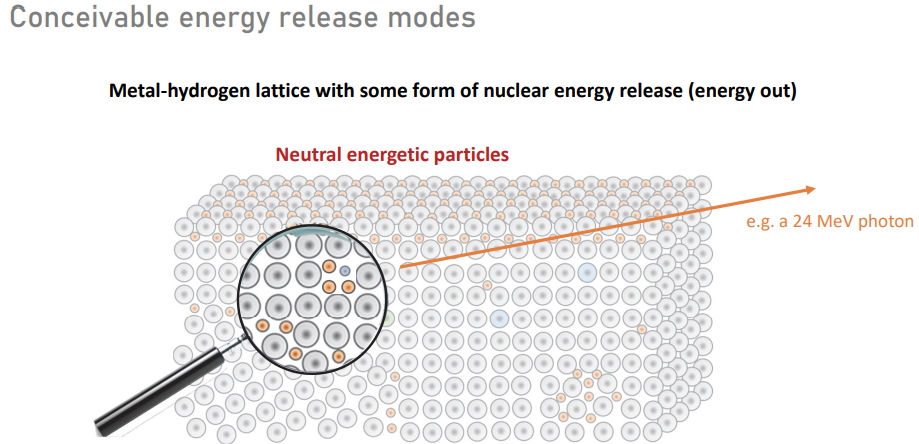
----------------------------------------------------------------------------------------------------------------------------------------
Conceivable energy release modes
Metal‐hydrogen lattice with some form of nuclear energy release (energy out)
Neutral energetic particles
e.g. a 24 MeV photon
----------------------------------------------------------------------------------
Conceivable energy release modes
Metal‐hydrogen lattice with some form of nuclear energy release (energy out)
Charged energetic particles
e.g. 1 MeV alphas
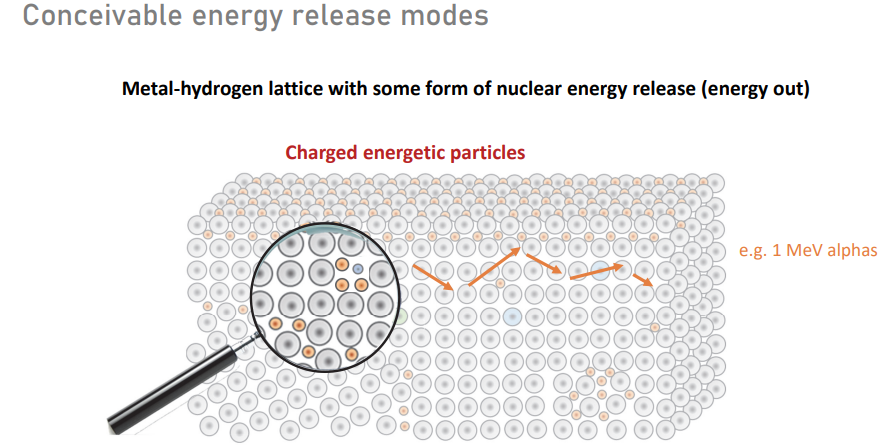
----------------------------------------------------------------
Conceivable energy release modes
Metal‐hydrogen lattice with some form of nuclear energy release (energy out)
Triggering secondary nuclear reactions
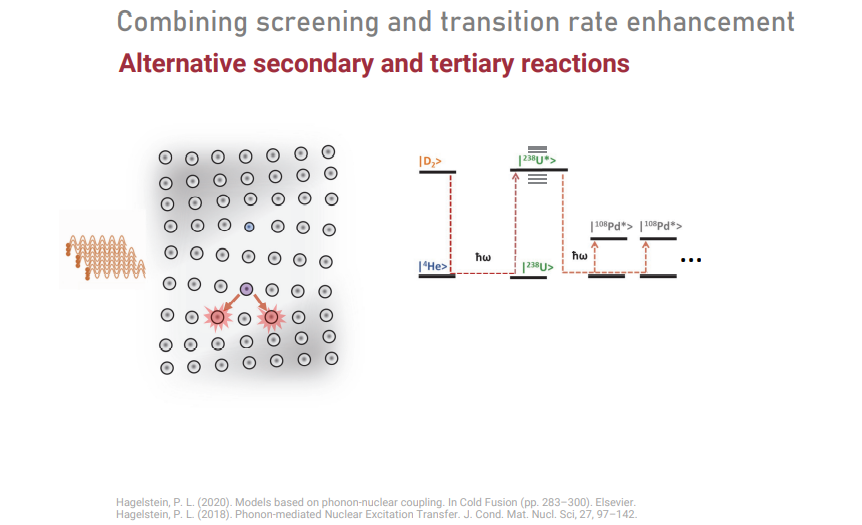
---------------------------------------------------------------------
Experimental setup: View of target sample during 28 MeV charged particle counts from bombarded Ti foil vacuum chamber with low‐energy deuteron bombardment beam on foil target
Forbes, S. (2019). Initial report on low-energy ion beam experiments with various metal targets [Conference Presentation]. ICCF22, Assisi, Italy. 54
Characterization mode: composition changes Example: He-4 production from loaded Pd foil
Anomalous Neutron Emission
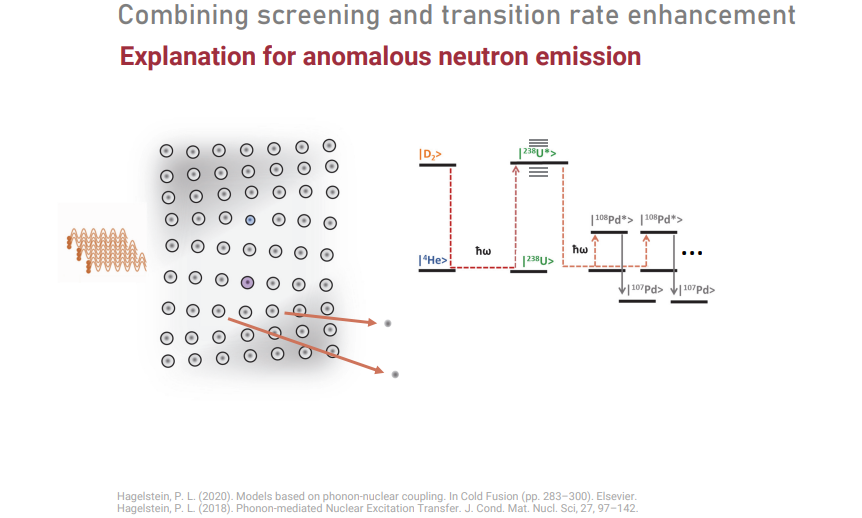
Measured He‐4 (top) and excess heat Experimental setup: similarity (bottom) appearing correlated to Fleischmann‐Pons cell
Gozzi, D., et al (1998). X-ray, heat excess and 4He in the D/Pd system. J. Electroanal. Chem, 452. 55 Characterization mode: composition & morphology changes Example: Possible fission products from gas loaded Pd
Biberian, J.-P. (2020, November 21). Transmutation induced by laser irradiation. RNBE 2020 Conference by French Society for Nuclear Science in Condensed Matter (SFSNMC), Paris.
-----------------------------------------------------------------------
Characterization mode: composition & morphology changes CPS Example: Possible fission products from gas loaded Pd (2) Pd 400 CPS
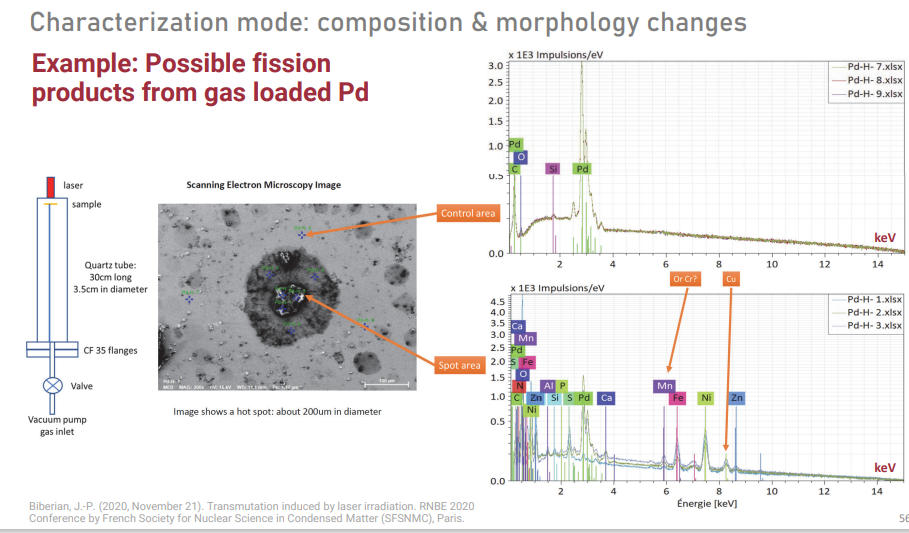
Fralick, G. C., Hendricks, R. C., Jennings, W. D., Benyo, T. L., VanKeuls, F. W., Ellis, D. L., Steinetz, B. M., Forsley, L. P., & Sandifer, C. E. (2020). Transmutations observed from pressure keV cycling palladium silver metals with deuterium gas. International Journal of Hydrogen Energy, 45(56), 32320–32330.
------------------------------------------------------------------------------------------------
Hagelstein, P. L., et al (2010). Terahertz difference frequency response of pdd in two-laser experiments. MIT Dspace. https://dspace.mit.edu/handle/1721.1/71612 Rowe, J. M., et al (1974). Lattice Dynamics of a Single Crystal of Pd D 0.63. Physical Review Letters, 33, 1297.
Characterization modes
What can we learn from reviewing the LENR literature from this perspective?
Two main lessons
Lesson I: relevant to Lesson II: relevant to the irrefutability challenge the reproducibility challenge peaks
Lesson II: relevant to the reproducibility challenge
Too many question marks Too many uncontrolled/uncharacterized variables
Need to characterize and/or control lattice and stimulation characteristics of experiments that show effects more comprehensively.
-----------------------------------------------------------------------------------------------------------------------
C. Implications for future research Implications
What do these lessons mean for future research?
We propose a two‐pronged approach to respond to these lessons and to address the irrefutability challenge and the reproducibility challenge.
Top‐down: Focus on a small number of experiments and conduct comprehensive characterizations. Bottom‐up: Design hypothesis‐driven experiments with simple, highly controlled samples predicted to exhibit LENR effects. 69 Implications
What do these lessons mean for future research?
We propose a two‐pronged approach to respond to these lessons and to address the irrefutability challenge and the reproducibility challenge.
Top‐down: Focus on a small number of experiments and conduct comprehensive characterizations. Bottom‐up: Design hypothesis‐driven experiments with simple, highly controlled samples predicted to exhibit LENR effects. peaks 72 Implications
What do these lessons mean for future research?
We propose a two‐pronged approach to respond to these lessons and to address the irrefutability challenge and the reproducibility challenge.
Top‐down: Focus on a small number of experiments and conduct comprehensive characterizations. Bottom‐up: Design hypothesis‐driven experiments with simple, highly controlled samples predicted to exhibit LENR effects.
Bottom-up approach
Thinking about mechanisms
What is known and accepted in the wider literature about enhancing nuclear transitions:
• Atomic physics Want lattice with • Electrons can increase proximity between nuclei. high screening and • Vacancies allow for both close proximity and high electron close proximity density in the lattice.
• Quantum dynamics: • Photons, phonons, plasmons, etc. can cause couplings Want to externally between nuclei. induce weak couplings • Couplings can intensify with coherence. and enhance via • Strong couplings can change state transition and reaction superradiance parameters.
Prados-Estévez, F. M., Subashiev, A. V., & Nee, H. H. (2017). Strong screening by lattice confinement and resultant fusion reaction rates in fcc metals. Nuclear Instruments and Methods in Physics Research Section B: Beam Interactions with Materials and Atoms, 407, 67–72. Terhune, J. H., & Baldwin, G. C. (1965). Nuclear Superradiance in Solids. Physical Review Letters, 14(15), 589–591.
------------------------------------------------------------
Combining screening and transition rate enhancement Start with an isolated D pair
Koonin, S. E., & Nauenberg, M. (1989). Calculated fusion rates in isotopic hydrogen molecules. Nature, 339(6227), 690. 75 Combining screening and transition rate enhancement Place D pair in a vacancy of a Pd lattice
Doped Pd lattice with vacancy hydrogen clusters: DD distance <100 pm Screening potential > 150 eV
Targosz-Ślȩczka, N., Czerski, K., Huke, A., Ruprecht, G., Weissbach, D., Martin, L., Kaczmarski, M., & Winter, H. (2013). Experiments on screening effect in deuteron fusion reactions at extremely low energies. The European Physical Journal Special Topics, 222(9), 2353–2359.
--------------------------------------------------------------------
Combining screening and transition rate enhancement Add resonant receiver nuclei as dopants
Add U‐238 doping
Doped Pd lattice with vacancy hydrogen clusters: DD distance <100 pm Screening potential > 150 eV
Stimulate with 10^‐10/s coherent photons at 10 THz
Hagelstein, P. L. (2020). Models based on phonon-nuclear coupling. In Cold Fusion (pp. 283–300). Elsevier. Hagelstein, P. L. (2018). Phonon-mediated Nuclear Excitation Transfer. J. Cond. Mat. Nucl. Sci, 27, 97–142.
---------------------------------------------------------------------
Combining screening and transition rate enhancement
kinetic energy (classical) ≙ state occupation probability (quantum)
Briggs, J. S., & Eisfeld, A. (2012). Coherent quantum states from classical oscillator amplitudes. Physical Review A, 85(5), 052111.
-----------------------------------------------------
Caution: This implies that in some configurations you would expect observable energetic particles ‐‐ and in others you would not! 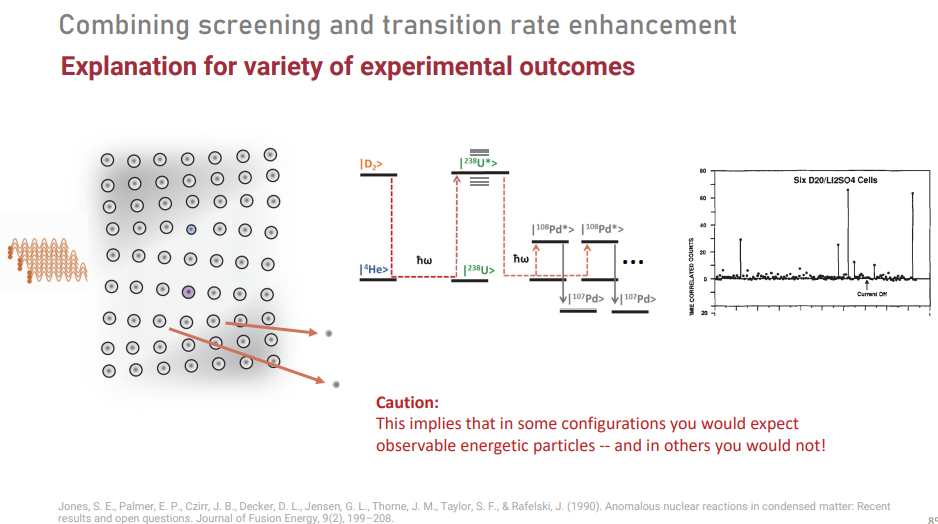
Jones, S. E., Palmer, E. P., Czirr, J. B., Decker, D. L., Jensen, G. L., Thorne, J. M., Taylor, S. F., & Rafelski, J. (1990). Anomalous nuclear reactions in condensed matter: Recent results and open questions. Journal of Fusion Energy, 9(2), 199–208.
-----------------------------------------------------------------------------
----------------------------------------------------------------------
Conclusions Conclusions
Key points
• A reference experiment needs to be both reproducible and unambiguous. • Historically, emphasis has been on characterization modes that leave too much room for alternative explanations (heat) high ambiguity/low irrefutability. • Going forward, prioritize characterization modes that are intrinsically more unambiguous (e.g. Raman spectroscopy for lattice dynamics). • There are still too many uncharacterized/uncontrolled variables in any of the major experiments low reproducibility. 92 Conclusions
Key points (2)
• In future research, employ a two‐pronged approach:
Top‐down: comprehensive characterization of a small number of legacy experiments (focus!)
Bottom‐up: simple experiments with precise specifications based on hypotheses about mechanism; connect with adjacent literatures on accelerated state transitions
I saw that. I’m glad to see you still here. I’ve been elsewhere on Facebook causing trouble over the viral C19 artificial virus matter in the larger context of the C19 social engineering scam.
I’ll have to see what the lay of the land is here on the subjects.
There’s a lot of back & forth between people who trust the C19 “vaccination-which-isn’t-a-vaccine” and those who don’t.
There’s additional invective about the Vax MANDATES.
Here’s how I look at it:
Folks are called anti-vaxxers even though we’re pro-vaccine. These messengerRNA gene therapy sequences don’t stop the spread of the disease nor its transmission, so they should only qualify as treatments rather than vaccines and shouldn’t get liability protection from the FDA. There’s growing evidence that the ‘vax’ actually harms people such as children and athletes.
Animation from SuperWave’s site.
https ://www.mail-archive.com/vortex-l@eskimo.com /msg77444.html
Found at Vortex-L, but since it has a dot com in the html phrase it doesn’t work as a link... you have to copy & paste it as a URL.
https://www.mail-archive.com/vortex-
About 3:40 into the animation. I found it at Superwaves’s site
I believe all of the claims up to 3:40 are based on conventional
electrochemistry. At that point the narrator claims that that D ions at
high concentration in the lattice begin moving together “like a school of
fish,” and then they fuse. That may be true but it is not conventional.
- Jed
Note that the latest theories show unidimensional vortices like little tiny tornadoes are being generated rather than viewing it as a piston going up & down in the lattice.
https://phys.org/news/2015-08-world-quietest-gas-physicists-faint.html
V1DLLBEC theory
Vibrating 1 Dimensional Luttinger Liquid Bose-Einstein Condensate
I might add in “Tiny Tornadoes” or “Vortices”. Or even “Vortician” to be inclusive of Vortices at the same time as giving a hat tip to Vortex-L mailing list.
Maybe VV1DLLBEC
Vibrating Vorticianal 1 Dimensional Luttinger Liquid Bose-Einstein Condensate
Disclaimer: Opinions posted on Free Republic are those of the individual posters and do not necessarily represent the opinion of Free Republic or its management. All materials posted herein are protected by copyright law and the exemption for fair use of copyrighted works.